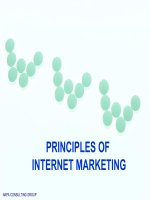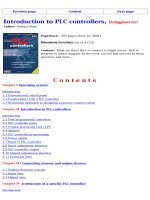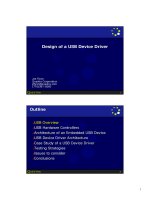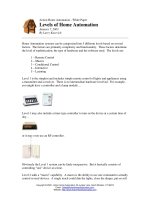Tài liệu Design Of Fuzzy Controllers doc
Bạn đang xem bản rút gọn của tài liệu. Xem và tải ngay bản đầy đủ của tài liệu tại đây (253.44 KB, 27 trang )
Design Of Fuzzy Controllers
Jan Jantzen :
1
$EVWUDFW
Design of a fuzzy controller requires more design decisions than usual, for example
regarding rule base, inference engine, defuzzification, and data pre- and post processing.
This tutorial paper identifies and describes the design choices related to single-loop fuzzy
control, based on an international standard which is underway. The paper contains also a
design approach, which uses a PID controller as a starting point. A design engineer can
view the paper as an introduction to fuzzy controller design.
&RQWHQWV
,QWURGXFWLRQ
6WUXFWXUH RI D IX]]\ FRQWUROOHU
2.1 Preprocessing 6
2.2 Fuzzification 7
2.3 Rule Base 7
2.4 Inference Engine 13
2.5 Defuzzification 15
2.6 Postprocessing 16
7DEOH %DVHG &RQWUROOHU
,QSXW2XWSXW 0DSSLQJ
7DNDJL6XJHQR 7\SH &RQWUROOHU
6XPPDU\
$ $GGLWLYH 5XOH %DVH
Technical University of Denmark, Department of Automation, Bldg 326, DK-2800 Lyngby, DENMARK.
Tech. report no 98-E 864 (design), 19 Aug 1998.
1
,QWURGXFWLRQ
While it is relatively easy to design a PID controller, the inclusion of fuzzy rules creates
many extra design problems, and although many introductory textbooks explain fuzzy con-
trol, there are few general guidelines for setting the parameters of a simple fuzzy controller.
The approach here is based on a three step design procedure, that builds on PID control:
1. Start with a PID controller.
2. Insert an equivalent, linear fuzzy controller.
3. Make it gradually nonlinear.
Guidelines related to the different components of the fuzzy controller will be intro-
duced shortly. In the next three sections three simple realisations of fuzzy controllers are
described: a table-based controller, an input-output mapping and a Takagi-Sugeno type
controller. A short section summarises the main design choices in a simple fuzzy controller
by introducing a check list. The terminology is based on an international standard which is
underway (IEC, 1996).
Fuzzy controllers are used to control consumer products, such as washing machines,
video cameras, and rice cookers, as well as industrial processes, such as cement kilns,
underground trains, and robots. Fuzzy control is a control method based on fuzzy logic.
Just asfuzzylogiccan bedescribed simply as ’’computingwith words rather than numbers’’,
fuzzy control can be described simply as ’’control with sentences rather than equations’’.
A fuzzy controller can include empirical rules, and that is especially useful in operator
controlled plants.
Take for instance a typical fuzzy controller
1. If error is Neg and change in error is Neg then output is NB
2. If error is Neg and change in error is Zero then output is NM (1)
The collection of rules is called a UXOH EDVH. The rules are in the familiar if-then format, and
formally the if-side is called the FRQGLWLRQ and the then-side is called the FRQFOXVLRQ (more
often, perhaps, the pair is called DQWHFHGHQW - FRQVHTXHQW or SUHPLVH - FRQFOXVLRQ). The
input value ’’Neg’’ is a OLQJXLVWLF WHUP short for the word 1HJDWLYH the output value ’’NB’’
stands for 1HJDWLYH %LJ and ’’NM’’ for 1HJDWLYH 0HGLXP. The computer is able to execute
the rules and compute a control signal depending on the measured inputs HUURU and FKDQJH
LQ HUURU.
The objective here is to identify and explain the various design choices for engineers.
In a rule based controller the controlstrategy is stored in a more or less naturallanguage.
The control strategy is isolated in a rule base opposed to an equation based description. A
rulebased controller is easy to understand and easy to maintain for a non-specialist end-user.
An equivalent controller could be implemented using conventional techniques in fact,
any rule based controller could be emulated in, say, )RUWUDQ it is just that it is convenient
2
Deviations
Actions
Outputs
Ref
Controller
End-user
Inference
engine
Rule
base
Process
Figure 1: Direct control.
to isolate the control strategy in a rule base for operator controlled systems.
Fuzzy controllers are being used in various control schemes (IEC, 1996). The most
obvious one is GLUHFW FRQWURO, where the fuzzy controller is in the forward path in a feedback
control system (Fig. 1). The process output is compared with a reference, and if there is
a deviation, the controller takes action according to the control strategy. In the figure, the
arrows may be understood as hyper-arrows containing several signals at a time for multi-
loop control. The sub-components in the figure will be explained shortly. The controller is
here a fuzzy controller, and it replaces a conventional controller, say, a 3,' (proportional-
integral-derivative) controller.
In IHHGIRUZDUG FRQWURO (Fig. 2) a measurable disturbance is being compensated. It re-
quires a good model, but if a mathematical model is difficult or expensive to obtain, a fuzzy
model may be useful. Figure 2 shows a controller and the fuzzy compensator, the process
and the feedback loop are omitted for clarity. The scheme, disregarding the disturbance in-
put, can be viewed as a collaboration of linear and nonlinear control actions; the controller
C may be a linear PID controller, while the fuzzy controller F is a supplementary nonlinear
controller
Fuzzy rules are also used to correct tuning parameters in SDUDPHWHU DGDSWLYH FRQWURO
schemes (Fig. 3). If a nonlinear plant changes operating point, it may be possible to
change the parameters of the controller according to each operating point. This is called
JDLQ VFKHGXOLQJ since it was originally used to change process gains. A gain scheduling
controller contains a linear controller whose parameters are changed as a function of the
operating point in a preprogrammed way. It requires thorough knowledge of the plant, but
it is often a good way to compensate for nonlinearities and parameter variations. Sensor
measurements are used as VFKHGXOLQJ YDULDEOHV that govern the change of the controller
parameters, often by means of a table look-up.
Whether a fuzzy control design will be stable is a somewhat open question. Stability
concerns the system’s ability to converge or stay close to an equilibrium. A VWDEOH linear
system will converge to the equilibrium asymptotically no matter where the system state
variables start from. It is relatively straight forward to check for stability in linear systems,
3
+
+
Sum
F
Fuzzy
compensator
C
Controller
u
Deviation
Disturbance
Figure 2: Feedforward control.
Outputs
Ref
Controller
Process
Fuzzy gain
schedule
Controller
parameters
Figure 3: Fuzzy parameter adaptive control.
4
for example by checking that all eigenvalues are in the left half of the complex plane. For
nonlinear systems, and fuzzy systems are most often nonlinear, the stability concept is more
complex. A nonlinear system is said to be DV\PSWRWLFDOO\ VWDEOH if, when it starts close to
an equilibrium, it will converge to it. Even if it just stays close to the equilibrium, without
converging to it, it is said to be VWDEOH (in the sense of Lyapunov). To check conditions for
stability is much more difficult with nonlinear systems, partly because the system behav-
iour is also influenced by the signal DPSOLWXGHV apart from the IUHTXHQFLHV. The literature
is somewhat theoretical and interested readers are referred to Driankov, Hellendoorn &
Reinfrank (1993) or Passino & Yurkovich (1998). They report on four methods (Lyapunov
functions, Popov, circle, and conicity), and they give several references to scientific papers.
It is characteristic, however, that the methods give rather conservative results, which trans-
late into unrealistically small magnitudes of the gain factors in order to guarantee stability.
Another possibility is to approximate the fuzzy controller with a linear controller, and
then apply the conventional linear analysis and design procedures on the approximation. It
seems likely that the stability margins of the nonlinear system would be close in some sense
to the stability margins of the linear approximation depending on how close the approxi-
mation is. This paper shows how to build such a linear approximation, but the theoretical
background is still unexplored.
There are at least four main sources for finding control rules (Takagi & Sugeno in Lee,
1990).
([SHUW H[SHULHQFH DQG FRQWURO HQJLQHHULQJ NQRZOHGJH One classical example is the
operator’s handbook for a cement kiln (Holmblad & Ostergaard, 1982). The most com-
mon approach to establishing such a collection of rules of thumb, is to question experts
or operators using a carefully organised questionnaire.
%DVHG RQ WKH RSHUDWRU¶V FRQWURO DFWLRQV Fuzzy LIWKHQ rules can be deduced from ob-
servations of an operator’s control actions or a log book. The rules express input-output
relationships.
%DVHG RQ D IX]]\ PRGHO RI WKH SURFHVV A linguistic rule base may be viewed as an
inverse model of the controlled process. Thus the fuzzy control rules might be obtained
by inverting a fuzzy model of the process. This method is restricted to relatively low
order systems, but it provides an explicit solution assuming that fuzzy models of the
open and closed loop systems are available (Braae & Rutherford in Lee, 1990). Another
approach is IX]]\ LGHQWLILFDWLRQ (Tong; Takagi & Sugeno; Sugeno – all in Lee, 1990;
Pedrycz, 1993) or fuzzy model-based control (see later).
%DVHG RQ OHDUQLQJ The self-organising controller is an example of a controller that
finds the rules itself. Neural networks is another possibility.
There is no design procedure in fuzzy control such as root-locus design, frequency re-
sponse design, pole placement design, or stability margins, because the rules are often non-
linear. Therefore we will settle for describing the basic components and functions of fuzzy
controllers, in order to recognise and understand the various options in commercial soft-
ware packages for fuzzy controller design.
There is much literature on fuzzy control and many commercial software tools (MIT,
5
1995), but there is no agreement on the terminology, which is confusing. There are efforts,
however, to standardise the terminology, and the following makes use of a draft of a stan-
dard from the International Electrotechnical Committee (IEC, 1996). Throughout, letters
denoting matrices are in bold upper case, for example $; vectors are in bold lower case,
for example [; scalars are in italics, for example Q; and operations are in bold, for example
PLQ.
6WUXFWXUH RI D IX]]\ FRQWUROOHU
There are specific components characteristic of a fuzzy controller to support a design pro-
cedure. In the block diagram in Fig. 4, the controller is between a preprocessing block and
a post-processing block. The following explains the diagram block by block.
Fuzzy controller
Inference
engine
Rule
base
Defuzzi-
fication
Postpro-
cessing
Fuzzi-
fication
Prepro-
cessing
Figure 4: Blocks of a fuzzy controller.
3UHSURFHVVLQJ
The inputs are most often hard or FULVS measurements from some measuring equipment,
ratherthan linguistic. A preprocessor, the first block in Fig. 4, conditionsthe measurements
before they enter the controller. Examples of preprocessing are:
Quantisation in connection with sampling or rounding to integers;
normalisation or scaling onto a particular, standard range;
filtering in order to remove noise;
averaging to obtain long term or short term tendencies;
a combination of several measurements to obtain key indicators; and
differentiation and integration or their discrete equivalences.
A TXDQWLVHU is necessary to convert the incoming values in order to find the best level
in a discrete XQLYHUVH. Assume, for instance, that the variable HUURU has the value 4.5, but
the universe is X @+8> 7>===>3>===>7> 8,. The quantiser rounds to 5 to fit it to the
nearest level. Quantisation is a means to reduce data, but if the quantisation is too coarse
the controller may oscillate around the reference or even become unstable.
Nonlinear VFDOLQJ isan option (Fig. 5). In the )/ 6PLGWK controllerthe operator is asked
6
-5 0 5
-100
0
100
input
scaled input
Figure 5: Example of nonlinear scaling of an input measurement.
to enter three typical numbers for a small, medium and large measurement respectively
(Holmblad & Østergaard, 1982). They become break-points on a curve that scales the
incoming measurements (circled in the figure). The overall effect can be interpreted as a
distortion of the primary fuzzy sets. It can be confusing with both scaling and gain factors
in a controller, and it makes tuning difficult.
Whenthe input to the controller is HUURU, thecontrol strategy is a static mapping between
input and control signal. A dynamic controller would have additional inputs, for example
derivatives, integrals, or previous values of measurements backwards in time. These are
created in the preprocessor thus making the controller multi-dimensional, which requires
many rules and makes it more difficult to design.
The preprocessor then passes the data on to the controller.
)X]]LILFDWLRQ
The first block inside the controller is IX]]LILFDWLRQ, which converts each piece of input
data to degrees of membership by a lookup in one or several membership functions. The
fuzzification block thus matches the input data with the conditions of the rules to determine
how well the condition of each rule matches that particular input instance. There is a degree
of membership for each linguistic term that applies to that input variable.
5XOH %DVH
The rules may use several variables both in the condition and the conclusion of the rules.
Thecontrollerscanthereforebe applied to bothmulti-input-multi-output (MIMO) problems
and single-input-single-output (SISO) problems. The typical SISO problem is to regulate
a control signal based on an error signal. The controller may actually need both the HUURU,
the FKDQJH LQ HUURU,andtheDFFXPXODWHG HUURU as inputs, but we will call it single-loop
control, because in principle all three are formed from the error measurement. To simplify,
this section assumes that the control objective is to regulate some process output around a
prescribed setpoint or reference. The presentation is thus limited to single-loop control.
5XOH IRUPDWV Basically a linguistic controller contains rules in the LIWKHQ format, but
they can be presented in different formats. In many systems, the rules are presented to the
7
end-user in a format similar to the one below,
1. If error is Neg and change in error is Neg then output is NB
2. If error is Neg and change in error is Zero then output is NM
3. If error is Neg and change in error is Pos then output is Zero
4. If error is Zero and change in error is Neg then output is NM
5. If error is Zero and change in error is Zero then output is Zero (2)
6. If error is Zero and change in error is Pos then output is PM
7. If error is Pos and change in error is Neg then output is Zero
8. If error is Pos and change in error is Zero then output is PM
9. If error is Pos and change in error is Pos then output is PB
The names =HUR, 3RV, 1HJ are labels of fuzzy sets as well as 1%, 10, 3% and 30
(negative big, negativemedium, positive big, and positive medium respectively). The same
set of rules could be presented in a UHODWLRQDO format, a more compact representation.
Error Change in error Output
Neg Pos Zero
Neg Zero NM
Neg Neg NB
Zero Pos PM
Zero Zero Zero
Zero Neg NM
Pos Pos PB
Pos Zero PM
Pos Neg Zero
(3)
The top row is the heading, with the names of the variables. It is understood that the two
leftmost columns are inputs, the rightmost is the output, and each row represents a rule.
This format is perhaps better suited for an experienced user who wants to get an overview
of the rule base quickly. The relational format is certainly suited for storing in a relational
database. It shouldbe emphasised, though, that the relationalformatimplicitly assumes that
the connective between the inputs is always logical DQG or logical RU for that matter as
longas it is thesame operationfor all rules and not a mixture of connectives. Incidentally,
a fuzzy rule with an RU combination of terms can be converted into an equivalent DQG
combination of terms using laws of logic (DeMorgan’s laws among others). A third format
is the tabular linguistic format.
Change in error
Neg Zero Pos
Neg NB NM Zero
Error Zero NM Zero PM
Pos Zero PM PB
(4)
This is even more compact. The input variables are laid out along the axes, and the output
variableis inside the table. In case the table has an empty cell, it is an indication of a missing
8
rule, andthis formatis usefulfor checking completeness. When the input variables are HUURU
and FKDQJH LQ HUURU, as they are here, that format is also called a OLQJXLVWLF SKDVH SODQH.In
case there are qA5 input variables involved, the table grows to an q-dimensional array;
rather user-XQfriendly.
To accommodate several outputs, a nested arrangement is conceivable. A rule with
several outputs could also be broken down into several rules with one output.
Lastly, a graphical format which shows the fuzzy membership curves is also possible
(Fig. 7). This graphical user-interface can display the inference process better than the
other formats, but takes more space on a monitor.
&RQQHFWLYHV In mathematics, sentences are connected with the words DQG, RU, LIWKHQ
(or LPSOLHV,andLI DQG RQO\ LI, or modifications with the word QRW. These five are called
FRQQHFWLYHV. It also makes a difference how the connectives are implemented. The most
prominent is probably multiplication for fuzzy DQG instead of minimum. So far most of the
examples have only contained DQG operations, but a rule like ‘‘If error is very neg and not
zero or change in error is zero then ...’’ is also possible.
The connectives DQG and RU are always defined in pairs, for example,
DDQGE@ PLQ +D> E, minimum
DRUE@ PD[ +D> E, maximum
or
DDQGE@ D E algebraic product
DRUE@ D . E D E algebraic or probabilistic sum
(5)
There are other examples (e.g., Zimmermann, 1991, 64 65,, but they are more com-
plex.
0RGLILHUV A linguistic PRGLILHU, is an operation that modifies the meaning of a term.
For example, in the sentence ‘‘very close to 0’’, the word YHU\ modifies &ORVHWR which
is a fuzzy set. A modifier is thus an operation on a fuzzy set. The modifier YHU\ can be
defined as squaring the subsequent membership function, that is
YHU\ D @ D
5
(6)
Some examples of other modifiers are
H[WUHPHO\ D @ D
6
VOLJKWO\ D @ D
4
6
VRPHZKDW D @ PRUHRUOHVV D DQG QRW VOLJKWO\ D
A whole family of modifiers is generated by D
s
where s is any power between zero and
infinity. With s @ 4 the modifier could be named H[DFWO\, because it would suppress all
memberships lower than 1.0.
8QLYHUVHV Elementsofa fuzzy set are takenfroma XQLYHUVH RI GLVFRXUVH or just XQLYHUVH.
The universe contains all elements that can come into consideration. Before designing the
membership functions it is necessary to consider the universes for the inputs and outputs.
Take for example the rule
If error is Neg and change in error is Pos then output is 0
9
Naturally, the membership functions for 1HJ and 3RV must be defined for all possible
values of HUURU and FKDQJH LQ HUURU and a standard universe may be convenient.
Another consideration is whether the input membership functions should be continuous
or discrete. A continuous membership function is defined on a continuous universe by
means of parameters. A discrete membership function is defined in terms of a vector with
a finite number of elements. In the latter case it is necessary to specify the range of the
universe and the value at each point. The choice between fine and coarse resolution is a
trade off between accuracy, speed and space demands. The quantiser takes time to execute,
and if this time is too precious, continuous membership functions will make the quantiser
obsolete.
([DPSOH VWDQGDUG XQLYHUVHV 0DQ\ DXWKRUV DQG VHYHUDO FRPPHUFLDO FRQWUROOHUV XVH
VWDQGDUG XQLYHUVHV
7KH )/ 6PLGWK FRQWUROOHU IRU LQVWDQFH XVHV WKH UHDO QXPEHU LQWHUYDO ^4> 4`
$XWKRUV RI WKH HDUOLHU SDSHUV RQ IX]]\ FRQWURO XVHG WKH LQWHJHUV LQ ^9> 9`
$QRWKHU SRVVLELOLW\ LV WKH LQWHUYDO ^433> 433` FRUUHVSRQGLQJ WR SHUFHQWDJHV RI IXOO
VFDOH
<HW DQRWKHU LV WKH LQWHJHU UDQJH ^3> 73<8` FRUUHVSRQGLQJ WR WKH RXWSXW IURP D ELW
DQDORJ WR GLJLWDO FRQYHUWHU
$ YDULDQW LV ^537:> 537;` > ZKHUH WKH LQWHUYDO LV VKLIWHG LQ RUGHU WR DFFRPPRGDWH QHJ
DWLYH QXPEHUV
7KH FKRLFH RI GDWDW\SHV PD\ JRYHUQ WKH FKRLFH RI XQLYHUVH )RU H[DPSOH WKH YROWDJH
UDQJH ^8> 8` FRXOG EH UHSUHVHQWHG DV DQ LQWHJHU UDQJH ^83> 83` RU DV D IORDWLQJ SRLQW
UDQJH ^8=3> 8=3` D VLJQHG E\WH GDWDW\SH KDV DQ DOORZDEOH LQWHJHU UDQJH ^45;> 45:`
A way to exploit the range of the universes better is scaling. If a controller input mostly
uses just one term, the scaling factor can be turned up such that the whole range is used.
An advantage is that this allows a standard universe and it eliminates the need for adding
more terms.
0HPEHUVKLS IXQFWLRQV Every element in the universe of discourse is a member of a
fuzzy set to some grade, maybe even zero. The grade of membership for all its members
describes a fuzzy set, such as 1HJ. In fuzzy sets elements are assigned a JUDGH RI PHPEHU
VKLS, such that the transition from membership to non-membership is gradual rather than
abrupt. The set of elements that have a non-zero membership is called the VXSSRUW of the
fuzzy set. The function that ties a number to each element { of the universe is called the
PHPEHUVKLS IXQFWLRQ +{,.
The designer is inevitably faced with the question of how to build the term sets. There
are two specific questions to consider: (i) How does one determine the shape of the sets?
and (ii) How many sets are necessary and sufficient? For example, the HUURU in the position
controller uses the family of terms 1HJ, =HUR,and3RV. According to fuzzy set theory the
choice of the shape and width is subjective, but a few rules of thumb apply.
A term set should be sufficiently wide to allow for noise in the measurement.
10









